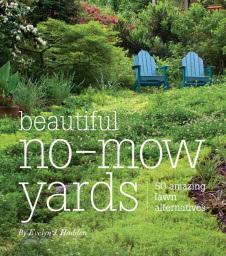
This book has suddenly become of great interest to me. Why is my interest now piqued? Because my back ‘lawn’ is nothing more than a quagmire. Due to the seemingly never-ending rain last year it has become very muddy and very compacted. It slopes, quite a bit which makes mowing really hard work and it is just a green space that I cross to get around the garden. I haven’t been happy with it for a while and feel the time has come to really consider an alternative.
Beautiful No Mow Lawns is written by a US author and has been written on the back of the growing movement in the US to move away from immaculate lawned front yards to something more sustainable and pleasing. I was surprised to learn that in some states in the US there are laws about the appearance of your front yard and as the author, Eveyln J Hadden, states “in some places, it is nothing less than unpatriotic to think of removing your front lawn”. Luckily we don’t have that problem here in the UK, although there are some gardens where it might be helpful if there were some laws that could be invoked! However, I do think that there is still a feeling that if you have a front lawn, as opposed to having paved it over for parking, it should be kept well.
The book sets out to show that there is a wealth of alternatives to the mown lawn all of which will be more sustainable, environmental, interesting and enjoyable. I was pleased to see that from the start the book sets out to address the lack of advice and information of moving away from lawns. The book is championed by Susan Harris, of GardenRant fame who found that her search for “‘lawn replacement’ usually yield just one solution: a big meadow.” I have tried this approach on the back lawn last year and it was awful and just didn’t work. Admittedly I only lasted six months before the lawn mower came out – it just looked messy and jarred with the rest of the garden.
Beautiful no-mow lawns is set out in three sections: Design Inspiration; How to get there; and Choice Ground-Layer Plants. The first section, for me, was the most inspirational. Most of the ideas were obvious but only when someone points them out to you. It is strange how replacing a lawn seems so much harder than it actually is; it’s all about changing your mindset. The alternatives are wide-ranging from patios, ponds, xeric gardens, the inevitable meadow and prairie garden. There is a section on play areas and as the author points out a large lawn will never provide the same stimulation and play opportunities as a garden full of plants, hidden corners, ponds, structures for a child – something worth considering when you feel wedded to that football pitch.
I looked at the ‘smarter lawns’ section in detail. This section provides a range of alternatives to the standard grass we have in lawns and the idea is that you accept that your lawn will be more fulsome, longer, with maybe seed heads, or scented if you choose something like thyme, chamomile. I have to be honest that this idea is just a non-starter for me, I have been conditioned from an early age that lawns need to be cut and maintained and look like lawns – a distinct difference to the borders. This has been my stumbling block.
However, the sections on shade gardens and stroll gardens have really got me thinking. Instead of a back lawn I could lift the grass and plant up a large border but run paths around the edge so that the various sections of the garden are linked by a network of paths, maybe with a seating area. Basically, it is obvious I don’t want a lawn that always looks awful when I can dig it up and replace it with another border maybe with a new focus.
The remaining two sections of the book are on ‘How to get there’ providing advice on the stages of removing a lawn, improving the soil and drainage, how to plant eco-friendly lawns and how to maintain it. The last section gives a wealth of plants that can be used to replace your lawn divided into: mounding plants, mat-forming plants, fill-in plants, minglers.
I found this book an eye-opener and wished that some of my neighbours who have replaced their front lawns with gravel and a few pots would consider a different approach. They might not have water hungry lawns but the replacement isn’t any better. As I have said there is nothing particularly revolutionary in the ideas, aside from the idea of ‘living carpets’, but what it does is bring all the alternatives together. They are presented with a range of case-studies, some acknowledging that the first attempt at replacing the lawn didn’t quite work, but all of them showing how much better the space could be used.
When you consider how much water we use to irrigate our lawns, “‘lawn’ is now recognised as the “largest irrigated crop” in the US” and the way our climates are so variable with extremes of rain, leading to flooding, and drought, leading to wasteful use of water in irrigating surely it is time for us to reconsider the everyday lawn. I suspect it will take a generation or two before we break the prejudices about a well-maintained lawn but I do think here in the UK we are well on the way and I hope the ‘Lawn Reform Coalition’ in the US proves to be successful.
If you are tired of maintaining your lawn or feel that you have a large wasted unused space covered in turf this is the book to get you thinking about the alternatives and maybe even encourage you to break with convention and dig up the turf.
Note: this book was provided as a review copy by Timberpress.

